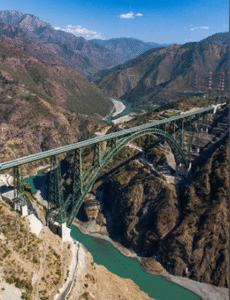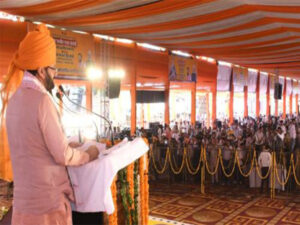11 years of India’s defence sector: From indigenous production to global exports and redefined national security
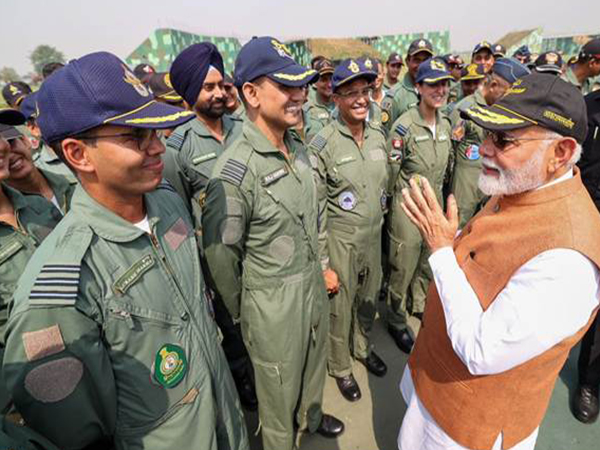
New Delhi [India], June 10 (ANI): India’s defence sector has witnessed an extraordinary transformation over the last eleven years under Prime Minister Narendra Modi’s leadership. The sector saw a steady rise in its defence budget, resulting in record-breaking production and a surge in exports.
The defence budget has steadily risen, from Rs 2.53 lakh crore in 2013-14 to Rs 6.81 lakh crore in 2025-26. This sharp increase reflects India’s commitment to strengthening its military foundations, according to a government release.
Private industry is now deeply involved, and innovation has taken centre stage. The development of Indigenous platforms, new-age technologies, and defence corridors shows how serious the government is about long-term preparedness.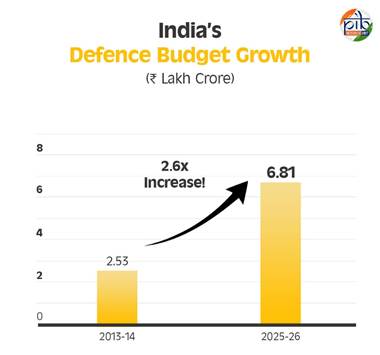
The results are striking. Record-breaking production, a surge in exports, targeted investments, and landmark defence contracts each point to a defence ecosystem on the rise. India is not just modernising its forces; it is shaping a new future where strength and self-reliance go hand in hand.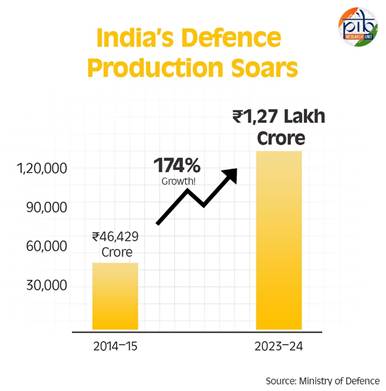
India’s defence manufacturing has seen a remarkable transformation in the last eleven years. In 2023-24, the country recorded its highest ever defence production, touching Rs 1.27 lakh crore. This is a sharp rise of 174 per cent compared to Rs 46,429 crore in 2014-15, according to the release.
The shift from import dependence to domestic production has been both strategic and swift. With clear political direction and consistent reforms, India has moved towards true self-reliance in defence. The focus has been on developing a strong industrial base anchored in indigenous design and manufacturing.
The government’s push to prioritise domestic procurement in defence acquisition has further boosted production. Public sector undertakings and private companies are both contributing to this new era of growth. From aircraft and missiles to surveillance systems and artillery, the range of indigenous products continues to expand.
Record defence contracts:
The Ministry of Defence signed 193 contracts worth Rs 2,09,050 crore in 2024-25 — the highest ever in a single year. Of these, 177 contracts were awarded to the domestic industry, amounting to Rs 1,68,922 crore, the release stated.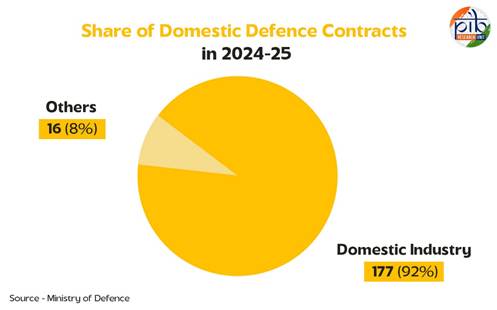
This shows a clear shift towards prioritising Indian manufacturers and strengthening the defence ecosystem within the country. The focus on indigenous procurement has also boosted job creation and technological advancement.
Additionally, Two dedicated Defence Industrial Corridors have been established in Uttar Pradesh and Tamil Nadu. These corridors have attracted investments worth over Rs 8,658 crore and signed 253 MoUs with an estimated investment potential of Rs 53,439 crore as of February 2025. Spread across 11 nodes in both states, these hubs are providing the infrastructure and incentives needed to turn India into a defence manufacturing powerhouse.
The government has issued five Positive Indigenisation Lists that limit imports and encourage local manufacturing. Over 5,500 items are covered under these lists, of which 3,000 had been indigenised by February 2025.
Key indigenised technologies include artillery guns, assault rifles, corvettes, sonar systems, transport aircraft, light combat helicopters (LCHs), radars, wheeled armoured platforms, rockets, bombs, armoured command post vehicles, and armoured dozers. This structured push has ensured that critical capabilities are now being built within the country.
Innovations for Defence Excellence (iDEX):
Launched in April 2018, Innovations for Defence Excellence (iDEX) has fostered a vibrant ecosystem for innovation and technology development in the defence and aerospace sectors. By engaging MSMEs, startups, individual innovators, R&D institutes, and academia, iDEX has provided grants of up to Rs 1.5 crore to support the development of cutting-edge technologies. Strengthening its impact, the Armed Forces have procured 43 items worth over Rs 2,400 crore from iDEX-supported startups and MSMEs, reflecting growing trust in indigenous innovation for defence preparedness, according to the release.
To further enhance self-reliance in defence technology, Rs 449.62 crore has been allocated to iDEX, including its sub-scheme Acing Development of Innovative Technologies with iDEX (ADITI), for 2025-26. As of February 2025, 549 problem statements have been opened, involving 619 startups and MSMEs, with 430 iDEX contracts signed.
Rise in defence export:
India’s defence exports have seen an extraordinary rise over the past eleven years. What once stood at just Rs686 crore in 2013-14 has soared to Rs23,622 crore in 2024-25. This marks a 34-fold increase and reflects the government’s sharp focus on building a self-reliant and globally competitive defence industry, according to the release
The transformation has not happened by chance. It is the outcome of clear vision, strong policy reforms and consistent efforts to boost domestic manufacturing. From easing export procedures to pushing for product diversification, the government has laid a strong foundation for global outreach.
Over 1,700 export authorisations were granted in 2024-25 alone. India now supplies a wide range of defence equipment to countries across the world. These include bulletproof jackets, patrol boats, helicopters, radars and even advanced systems like torpedoes. Major buyers include the United States, France and Armenia. Their interest signals growing trust in Indian defence products and the country’s credibility as a reliable supplier.
The target ahead is ambitious yet achievable. With plans to cross Rs50,000 crore in exports by 2029, India is moving steadily towards becoming a global hub for defence production. The last decade has made one thing clear. India is no longer just a buyer. It is fast becoming a builder and exporter of military strength.
Key defence acquisitions and approvals:
Over the past year, India has stepped up its defence preparedness with major acquisitions and approvals that underline the government’s commitment to modernisation and self-reliance. These decisions not only bolster military capabilities but also strengthen the domestic defence ecosystem.
BrahMos Missile Systems: In March 2024, the government signed a significant contract with BrahMos Aerospace Private Limited for the procurement of BrahMos missiles, valued at Rs 19,518.65 crore. These missiles will meet the Indian Navy’s operational and training needs. The project is expected to generate about nine lakh man-days of employment at the joint venture level and around 135 lakh man-days in ancillary industries, many of which are MSMEs. Additionally, a separate contract worth Rs988.07 crore was signed for the procurement of the ship-borne BrahMos missile system, according to release.
MQ-9B Drones: India finalised a key deal with the United States for the acquisition of 31 MQ-9B drones. These long-endurance unmanned aerial vehicles will enhance surveillance and precision capabilities across the armed forces.
Light Combat Helicopters (LCH) Prachand: On March 28, 2025, two contracts were signed with Hindustan Aeronautics Limited for the supply of 156 LCH Prachand helicopters, worth Rs62,700 crore (excluding taxes). The Indian Air Force will receive 66 helicopters and the Indian Army will get 90. Deliveries are scheduled to begin in the third year and continue over five years. Designed for high-altitude missions, Prachand has over 65 percent indigenous content and involves 250 domestic companies, mostly MSMEs, generating over 8,500 jobs.
Advanced Medium Combat Aircraft (AMCA): In May 2025, India’s defence sector achieved a major milestone with the approval of the Advanced Medium Combat Aircraft (AMCA) Programme Execution Model, a strategic initiative to boost indigenous aerospace capabilities. The Aeronautical Development Agency (ADA) will implement the programme through competitive industry partnerships, ensuring equal opportunities for both private and public sector players while mandating full compliance with Indian regulations.
Flight Refuelling Aircraft (FRA): The Ministry of Defence signed a wet lease agreement with Metrea Management for one KC-135 Flight Refuelling Aircraft. This is the first time the Indian Air Force has opted for a wet-leased FRA, which will be used for air-to-air refuelling training of pilots from both the Air Force and Navy. Delivery is expected within six months.
Advanced Towed Artillery Gun System (ATAGS): The Cabinet Committee on Security approved the procurement of 307 ATAGS along with 327 High Mobility 6×6 Gun Towing Vehicles at an estimated cost of Rs 7,000 crore. These guns will equip 15 artillery regiments. Developed by DRDO in partnership with Bharat Forge and Tata Advanced Systems, ATAGS features a firing range of over 40 kilometres, advanced fire control systems, automated loading, and recoil management. The system has been rigorously tested in diverse conditions and has proven its effectiveness and reliability, according to the release.
Nari Shakit in defence:
Women have taken centre stage in India’s defence forces over the last eleven years. In 2014, there were just around 3,000 women officers across the services. Today, that number has grown to over 11,000, reflecting a clear shift in policy and mindset. The current government has opened new doors for women in uniform. Permanent Commission has been granted to 507 women officers, allowing them to pursue long-term careers and take on leadership roles. This move has reshaped opportunities for women across ranks and branches, according to the release.
The National Defence Academy (NDA) has undergone a historic transformation by inducting female cadets, starting with the first batch of 17 in August 2022 as part of the 148th NDA course. Since then, 126 female cadets have joined across four batches, up to the 153rd course. On May 30, 2025, a landmark moment was marked when these 17 female cadets were among the 336 cadets who graduated from the 148th Course – Spring Term 2025. This shift reflects the broader integration of women across defence domains, from combat support to piloting fighter jets, underscoring the belief that strength and service transcend gender.
Counter-terrorism and internal security:
India’s firm and clear-eyed approach to internal security and counter-terrorism over the last eleven years reflects the government’s unwavering resolve to prioritise national interest above all. From precision military strikes across borders to strategic dismantling of insurgent networks within, India has shed the hesitations of the past. A clear doctrine now guides action, swift, decisive and backed by intelligence. With the abrogation of Article 370, the campaign against Naxalism, and new capabilities in high-tech defence, India today stands more secure and self-reliant than ever before. Operation SINDOOR, India’s swift and precise military response to a terror attack in April 2025, further demonstrated this resolve. These successes are a result of political will, military strength and a deeply rooted belief in putting the country first.
Surgical strikes and Balakot air strikes:
In a bold departure from past restraint, India responded to the terrorist attack in Uri on 18 soldiers by conducting Surgical Strikes on 28-29 September 2016. These strikes inflicted heavy losses on terrorists and their protectors across the Line of Control. A few years later, on 14 February 2019, the Pulwama terror attack claimed 40 CRPF jawans. India’s response came swiftly. On 26 February 2019, in an intelligence-led operation, the Balakot airstrikes eliminated a large number of Jaish-e-Mohammad terrorists, including senior commanders. The facility targeted was located far from civilian areas and headed by Maulana Yousuf Azhar, brother-in-law of JeM chief Masood Azhar. These pre-emptive actions showed the world that India would no longer tolerate proxy war through terrorism.
Operation SINDOOR
In April 2025, following a brutal terror attack on civilians in Pahalgam, India launched Operation SINDOOR, executing precise retaliatory strikes against nine terrorist camps in Pakistan and Pakistan-occupied Jammu and Kashmir. The Indian military, acting on accurate intelligence, relied on drone strikes, loitering munitions, and layered air defence to neutralise key threats without crossing international boundaries. Key command centers of Jaish-e-Mohammed (JeM) and Lashkar-e-Taiba (LeT) were destroyed, severely disrupting their operational capabilities. The strikes resulted in over 100 terrorists killed in action, including individuals linked to the IC-814 hijack and the Pulwama blast, like Yusuf Azhar, Abdul Malik Rauf and Mudassir Ahmad, according to the release.
When Pakistan launched drone and missile attacks on 7-8 May against multiple Indian cities and bases, these were swiftly intercepted, showcasing the effectiveness of India’s net-centric warfare systems and integrated counter-UAS (unmanned aerial systems) grid.
Counterterrorism measures in Jammu and Kashmir
On 5 August 2019, Parliament approved the removal of Article 370 and 35-A, marking a historic correction of a decades-old imbalance. Jammu & Kashmir and Ladakh were brought at par with other regions, and over 890 Central laws were applied. As many as 205 state laws were repealed, and 130 modified to align with the Constitution of India.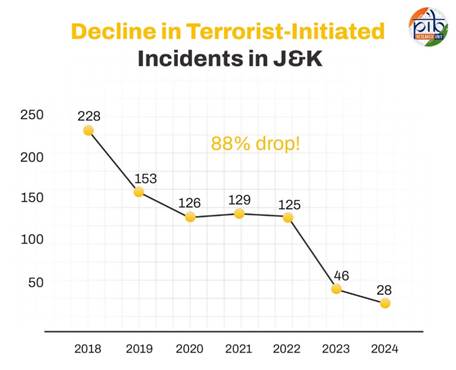
Since then, development in the region has accelerated. Marginalised groups like Valmikis, Dalits, and Gorkhas now enjoy full rights. Laws such as the Right to Education and Child Marriage Act now protect all citizens in the region. The impact is clear: terrorist-initiated incidents have dropped from 228 in 2018 to just 28 in 2024, demonstrating a strong correlation between integration and peace. Additionally, stone-pelting incidents have recorded a 100% drop, marking a new era of peace.
The successful conduct of the J&K Assembly Elections in 2024, held in three phases with a 63% voter turnout, further underscores the region’s embrace of democratic participation and stability, demonstrating a strong correlation between integration and peace.
Fight against Naxalism:
The multi-pronged approach to Left Wing Extremism has delivered historic gains. From 126 affected districts in 2010, the number has come down to just 38 by April 2024. Most affected districts were reduced from 12 to 6, and the number of casualties is at a 30-year low. Violence has declined sharply from 1,936 incidents in 2010 to 374 in 2024, an 81 per cent drop. Deaths have reduced by 85 per cent over the same period.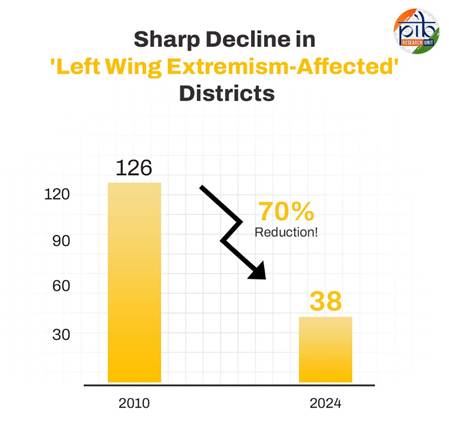
In 2024 alone, 290 Naxals were neutralised, 1,090 arrested, and 881 surrendered. Major recent operations in March 2025 saw 50 Naxals surrender in Bijapur, 16 neutralised in Sukma, and 22 killed in Kanker and Bijapur. Another landmark achievement came with Operation Black Forest in Chhattisgarh, where 27 dreaded Maoists, including Basavaraju, a general secretary ranked leader, the first such high-ranking neutralisation in 30 years, were eliminated. Additionally, 54 Naxalites were arrested, and 84 surrendered in this operation.
With continued support through Special Central Assistance and targeted development, the government is on track to eliminate Naxalism by 31 March 2026, the release added. (ANI)
This story is not been edited by Take One Television & Digital Network Staff and is auto-generated from syndicated feed



